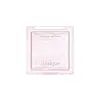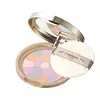What's inside
What's inside
 Key Ingredients
Key Ingredients

 Benefits
Benefits

 Concerns
Concerns

 Ingredients Side-by-side
Ingredients Side-by-side

Magnesium/Potassium/Silicon/Fluoride/Hydroxide/Oxide
Hydrogen Dimethicone
Mica
Cosmetic ColorantTriethoxycaprylylsilane
Hdi/Trimethylol Hexyllactone Crosspolymer
Silica
AbrasiveTalc
AbrasiveDimethicone
EmollientCetearyl Alcohol
EmollientIsopropyl Titanium Triisostearate
EmollientSynthetic Fluorphlogopite
CI 77891
Cosmetic ColorantAluminum Hydroxide
EmollientMethicone
EmollientGlycerin
HumectantPentylene Glycol
Skin ConditioningMagnesium Myristate
Sodium Acrylate/Sodium Acryloyldimethyl Taurate Copolymer
Emulsion StabilisingWater
Skin ConditioningIsohexadecane
EmollientPolysorbate 80
EmulsifyingSorbitan Oleate
EmulsifyingPolysorbate 20
EmulsifyingSodium Dehydroacetate
PreservativeCI 77007
Cosmetic ColorantMagnesium Aluminum Silicate
AbsorbentSorbitan Stearate
EmulsifyingSorbitan Olivate
EmulsifyingEthylhexylglycerin
Skin ConditioningTocopherol
AntioxidantKaolin
AbrasiveCI 73360
Cosmetic ColorantButylene Glycol
HumectantAgave Tequilana Leaf Extract
AstringentCentella Asiatica Leaf Extract
Skin ConditioningSpiraea Ulmaria Extract
AstringentCamellia Sinensis Leaf Extract
AntimicrobialMagnesium/Potassium/Silicon/Fluoride/Hydroxide/Oxide, Hydrogen Dimethicone, Mica, Triethoxycaprylylsilane, Hdi/Trimethylol Hexyllactone Crosspolymer, Silica, Talc, Dimethicone, Cetearyl Alcohol, Isopropyl Titanium Triisostearate, Synthetic Fluorphlogopite, CI 77891, Aluminum Hydroxide, Methicone, Glycerin, Pentylene Glycol, Magnesium Myristate, Sodium Acrylate/Sodium Acryloyldimethyl Taurate Copolymer, Water, Isohexadecane, Polysorbate 80, Sorbitan Oleate, Polysorbate 20, Sodium Dehydroacetate, CI 77007, Magnesium Aluminum Silicate, Sorbitan Stearate, Sorbitan Olivate, Ethylhexylglycerin, Tocopherol, Kaolin, CI 73360, Butylene Glycol, Agave Tequilana Leaf Extract, Centella Asiatica Leaf Extract, Spiraea Ulmaria Extract, Camellia Sinensis Leaf Extract
Talc
AbrasiveTitanium Dioxide
Cosmetic ColorantEthylhexyl Methoxycinnamate
UV AbsorberMica
Cosmetic ColorantLauroyl Lysine
Skin ConditioningPetrolatum
EmollientSilica
AbrasiveZinc Myristate
Diisostearyl Malate
EmollientVinyl Dimethicone/Methicone Silsesquioxane Crosspolymer
Hydroxyapatite
AbrasiveDipropylene Glycol
HumectantZinc Oxide
Cosmetic ColorantAluminum Hydroxide
EmollientEthylparaben
PreservativeMethylparaben
PreservativeSorbitan Isostearate
EmulsifyingDimethicone
EmollientEthylhexylglycerin
Skin ConditioningCaprylyl Glycol
EmollientWater
Skin ConditioningHydrogen Dimethicone
Sodium Dehydroacetate
PreservativeTin Oxide
AbrasiveDisodium Stearoyl Glutamate
CleansingButylene Glycol
HumectantArgania Spinosa Kernel Oil
EmollientSqualane
EmollientSimmondsia Chinensis Seed Oil
EmollientHydrogenated Polyisobutene
EmollientPropylene Glycol
HumectantBHT
AntioxidantAlcohol Denat.
AntimicrobialSodium Hyaluronate
HumectantPhenoxyethanol
PreservativeSaxifraga Sarmentosa Extract
Skin ConditioningCamellia Sinensis Leaf Extract
AntimicrobialChamomilla Recutita Flower Extract
MaskingRosa Centifolia Flower Extract
AstringentCitric Acid
BufferingSoluble Collagen
HumectantArnica Montana Flower Extract
MaskingHypericum Perforatum Extract
AntimicrobialHedera Helix Leaf/Stem Extract
AntimicrobialAesculus Hippocastanum Seed Extract
Skin ConditioningHamamelis Virginiana Leaf Extract
Skin ConditioningVitis Vinifera Leaf Extract
Skin ConditioningSodium Citrate
BufferingCI 77491
Cosmetic ColorantCI 77492
Cosmetic ColorantCI 73360
Cosmetic ColorantCI 19140
Cosmetic ColorantCI 77007
Cosmetic ColorantTalc, Titanium Dioxide, Ethylhexyl Methoxycinnamate, Mica, Lauroyl Lysine, Petrolatum, Silica, Zinc Myristate, Diisostearyl Malate, Vinyl Dimethicone/Methicone Silsesquioxane Crosspolymer, Hydroxyapatite, Dipropylene Glycol, Zinc Oxide, Aluminum Hydroxide, Ethylparaben, Methylparaben, Sorbitan Isostearate, Dimethicone, Ethylhexylglycerin, Caprylyl Glycol, Water, Hydrogen Dimethicone, Sodium Dehydroacetate, Tin Oxide, Disodium Stearoyl Glutamate, Butylene Glycol, Argania Spinosa Kernel Oil, Squalane, Simmondsia Chinensis Seed Oil, Hydrogenated Polyisobutene, Propylene Glycol, BHT, Alcohol Denat., Sodium Hyaluronate, Phenoxyethanol, Saxifraga Sarmentosa Extract, Camellia Sinensis Leaf Extract, Chamomilla Recutita Flower Extract, Rosa Centifolia Flower Extract, Citric Acid, Soluble Collagen, Arnica Montana Flower Extract, Hypericum Perforatum Extract, Hedera Helix Leaf/Stem Extract, Aesculus Hippocastanum Seed Extract, Hamamelis Virginiana Leaf Extract, Vitis Vinifera Leaf Extract, Sodium Citrate, CI 77491, CI 77492, CI 73360, CI 19140, CI 77007
 Reviews
Reviews

Ingredients Explained
These ingredients are found in both products.
Ingredients higher up in an ingredient list are typically present in a larger amount.
Aluminum Hydroxide is a form of aluminum. It can be naturally found in nature as the mineral gibbsite. In cosmetics, Aluminum Hydroxide is used as a colorant, pH adjuster, and absorbent.
As a colorant, Aluminum Hydroxide may add opacity, or reduce the transparency. Aluminum hydroxide is contains both basic and acidic properties.
According to manufacturers, this ingredient is an emollient and humectant. This means it helps hydrate the skin.
In medicine, this ingredient is used to help relieve heartburn and help heal ulcers.
There is currently no credible scientific evidence linking aluminum hydroxide in cosmetics to increased cancer risk.
Major health organizations allow the use of aluminum hydroxide in personal care products and have not flagged it as a carcinogenic risk at typical usage levels.
Learn more about Aluminum HydroxideButylene Glycol (or BG) is used within cosmetic products for a few different reasons:
Overall, Butylene Glycol is a safe and well-rounded ingredient that works well with other ingredients.
Though this ingredient works well with most skin types, some people with sensitive skin may experience a reaction such as allergic rashes, closed comedones, or itchiness.
Learn more about Butylene GlycolCamellia Sinensis Leaf Extract is derived from the leaves of the tea plant. Black tea, green tea, and oolong tea are all harvested from this plant.
This ingredient has many skin benefits:
This ingredient contains polyphenols, a strong antioxidant. Antioxidants help fight off molecules that damage skin cells.
On top of that, the antioxidants in green tea neutralize free-radicals from the sun. This gives the skin some extra UV protection, but should not replace sunscreen.
Many components of tea have anti-inflammatory properties.
Polyphenols and L-theanine help soothe the skin and reduce irritation. The caffeine in Camellia Sinensis Leaf Extract helps calm inflamed blood vessels.
Other compounds found in tea include: Vitamin Bs, linoleic acid, magnesium, calcium, iron, and zinc.
Research has shown both drinking Camellia Sinensis Leaf Tea and applying it to the skin can help boost skin elasticity and hydration. Studies also show using tea extract may reduce sebum, or oil, production.
Learn more about Camellia Sinensis Leaf ExtractCi 73360 is a synthetic red-pink dye.
This pigment is called Ultramarine blue lazurite. It gives a saturated blue color, but can be used to create other colors as well.
According to the manufacturer, it is usually made from kaolin, sodium sulfate, sodium carbonate, sulfur, and charcoal.
Dimethicone is a type of synthetic silicone created from natural materials such as quartz.
What it does:
Dimethicone comes in different viscosities:
Depending on the viscosity, dimethicone has different properties.
Ingredients lists don't always show which type is used, so we recommend reaching out to the brand if you have questions about the viscosity.
This ingredient is unlikely to cause irritation because it does not get absorbed into skin. However, people with silicone allergies should be careful about using this ingredient.
Note: Dimethicone may contribute to pilling. This is because it is not oil or water soluble, so pilling may occur when layered with products. When mixed with heavy oils in a formula, the outcome is also quite greasy.
Learn more about DimethiconeEthylhexylglycerin (we can't pronounce this either) is commonly used as a preservative and skin softener. It is derived from glyceryl.
You might see Ethylhexylglycerin often paired with other preservatives such as phenoxyethanol. Ethylhexylglycerin has been found to increase the effectiveness of these other preservatives.
Hydrogen Dimethicone is a type of silicone.
Mica is a naturally occurring mineral used to add shimmer and color in cosmetics. It can also help improve the texture of a product or give it an opaque, white/silver color.
Serecite is the name for very fine but ragged grains of mica.
This ingredient is often coated with metal oxides like titanium dioxide. Trace amounts of heavy metals may be found in mica, but these metals are not harmful in our personal products.
Mica has been used since prehistoric times throughout the world. Ancient Egyptian, Indian, Greek, Roman, Aztec, and Chinese civilizations have used mica.
Learn more about MicaSilica, also known as silicon dioxide, is a naturally occurring mineral. It is used as a fine, spherical, and porous powder in cosmetics.
Though it has exfoliant properties, the function of silica varies depending on the product.
The unique structure of silica enhances the spreadability and adds smoothness, making it a great texture enhancer.
It is also used as an active carrier, emulsifier, and mattifier due to its ability to absorb excess oil.
In some products, tiny microneedles called spicules are made from silica or hydrolyzed sponge. When you rub them in, they lightly polish away dead skin layers and enhance the penetration of active ingredients.
Learn more about SilicaThis ingredient is a preservative with antimicrobial properties. It is the sodium salt of dehydroacetic acid.
It is especially effective at preventing bacterial and fungal growth in low concentrations.
Talc is a clay mineral. It helps absorb moisture and improve the texture of products. Like other types of clay, Talc can have a slight exfoliating effect on skin. Talc can be added to increase the volume of products.
Some Baby powders are made by combining talc with corn starch. The word "talc" comes from Latin and originates from Arabic. Talc is a mineral commonly found throughout the world.
If you have any concerns about using talc, we recommend checking out the FDA's official page.
Learn more about TalcWater. It's the most common cosmetic ingredient of all. You'll usually see it at the top of ingredient lists, meaning that it makes up the largest part of the product.
So why is it so popular? Water most often acts as a solvent - this means that it helps dissolve other ingredients into the formulation.
You'll also recognize water as that liquid we all need to stay alive. If you see this, drink a glass of water. Stay hydrated!
Learn more about Water